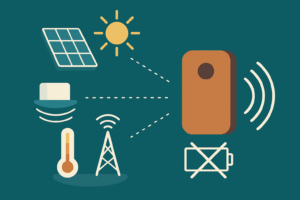In the age of ubiquitous connectivity, sensors are the backbone of automation, monitoring, and smart systems. Yet, powering these devices remains a challenge—especially when batteries introduce limitations in size, maintenance, cost, and sustainability.
Energy harvesting offers a compelling alternative: capturing ambient energy to power low-consumption electronics, enabling truly autonomous wireless sensors.
What Is Energy Harvesting?
Energy harvesting refers to the process of collecting small amounts of energy from the environment and converting it into electrical power. This allows devices to operate without batteries or wired power sources.
Common Energy Sources
There are several types of ambient energy that can be harvested:
- Mechanical vibrations – using piezoelectric or electromagnetic transducers, ideal in industrial environments with moving machinery.
- Light (solar or artificial) – via photovoltaic cells, suitable for outdoor or well-lit indoor spaces.
- Thermal gradients – exploiting temperature differences between surfaces.
- Radiofrequency (RF) – capturing energy from electromagnetic waves emitted by nearby readers or transmitters.

Kliskatek’s Approach: RF-Centric, But Flexible
At Kliskatek, we design sensors that can harvest energy from any of these sources, depending on the application. However, we primarily focus on RF energy harvesting, especially in sub-1 GHz bands, for one key reason: reliability.
Unlike other sources that depend on environmental conditions (light, heat, motion), RF energy can be guaranteed. In our systems, the reader not only communicates with the sensor but also powers it, ensuring consistent operation regardless of the surroundings.
This approach enables:
- Maintenance-free operation
- Compact and sustainable sensor design
- Deployment in challenging environments (e.g., enclosed spaces, low-light areas)
Conclusion
Energy harvesting is reshaping how we think about powering sensors. By leveraging RF energy—while remaining open to other sources—Kliskatek delivers flexible, robust, and battery-free solutions for the future of sensing.
Stay tuned for upcoming articles where we’ll dive deeper into our technology and real-world applications.
